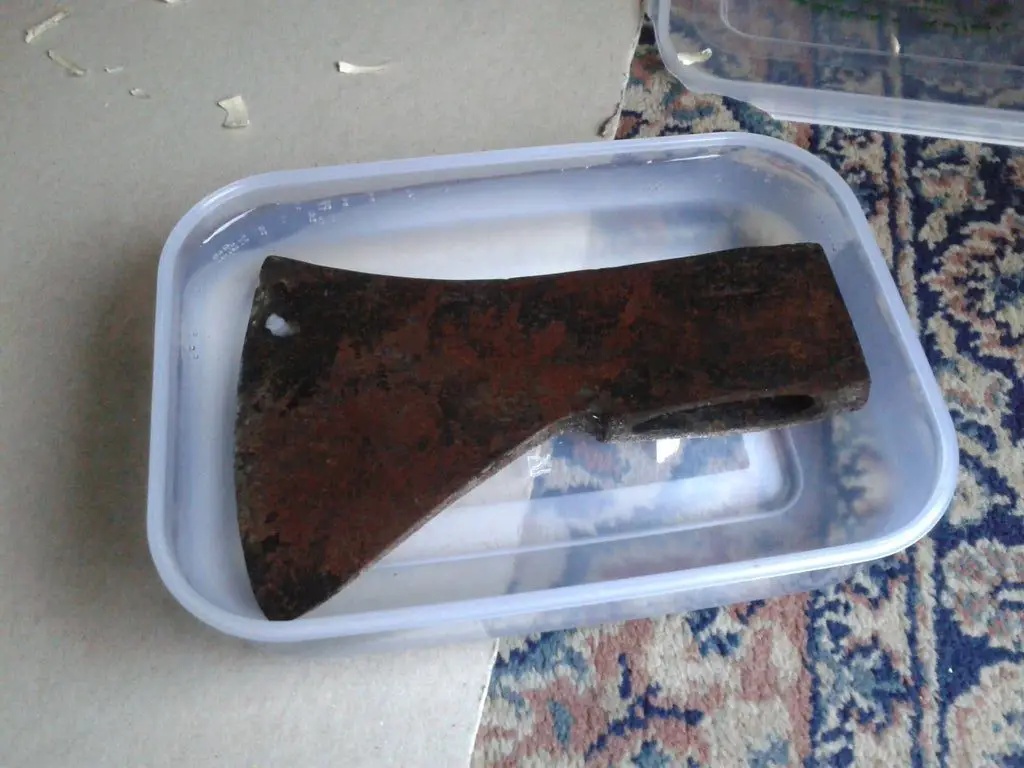To clean your axe of sap and rust, first remove sap using rubbing alcohol. Then, eliminate rust by applying white vinegar, letting it sit for 15-30 minutes, and scrubbing with steel wool or a wire brush. Finally, dry the axe and apply a protective coating of oil.
If you’ve ever had pine or any other sticky sap on your hands, you know how tough it can be to get off. Water by itself won’t do it. Even soap might not be effective. Tools covered in sap – especially sap that isn’t cleaned off and which hardens and builds up a layer over time – will gradually lose their effectiveness. Likewise, a tiny bit of rust might seem like nothing. Allow it to spread, however, and you’re putting your axe at risk of unnecessary erosion. This article will tell you how to clean your axe using various methods. You can banish annoying sap and damaging rust using a few household ingredients and tools.
A well-made axe can last long after you’re gone and still chop wood just as well as when it was first made. But you need to clean your axe to prolong its life by keeping it away from rust and removing any sticky sap and resin. Here are the ways to do that.
Table of Contents
Cleaning Sap And Resin Off of an Axe
Paint Thinner
Paint thinner is a hydrocarbon solvent. Like other mineral spirits, paint thinner is used to thin and remove oil and varnish finishes. It works well at eliminating gunk – including pine sap. If you have sap or resin on the axe head and handle, apply paint thinner. Let it soak in for a moment, then rub the offending material off.
Lighter Fluid
Slightly more volatile than paint thinner, using lighter fluid is another way to clean the sap off your axe. Many people love this solution because it’s easily accessible. Using a cotton rag, pour a bit of lighter fluid on the axe and wipe it down to remove the resin.
Acetone
A more effective way of removing the gunk is to use acetone. Acetone flashes off faster and emits a less toxic odor compared to the lighter fluid. It’s moderately expensive but a suitable cleaning solvent. Take a cotton ball or rag and wet it with some acetone. Rub the wet cotton on the axe head or handle smeared with sap or resin. It should come off quick.
Cleaning Rust Off of an Axe
Soak in White Vinegar
Put the axe (or axehead) into a plastic or metal container. Make sure that the height of the container is enough to submerge the axe head. Pour the white vinegar in until it covers the axehead entirely.
Set the container aside in a safe place. Leave the axe soaking for about 24 to 36 hours (this depends on the severity of the rusting). After a few hours, you’ll notice that bits of rust is coming off. This is due to the acetic acid found in the vinegar. If possible, remove the axehead from the handle. Soaking wood in vinegar can darken the wood due to the reaction between the vinegar, metallic axehead, and wood.

Use A Steel Brush or Steel Sponge
Once 24 to 36 hours have passed, get a steel brush or sponge and brush the axehead vigorously. The rust should come off with relative ease at this point. Don’t forget to work it into the axe eye, where the handle is fixed.
Wash With Warm Water
The vinegar scent is strong, so I usually remove the odor by washing the axe with warm water. Even if the smell isn’t gone after washing, it’ll work itself out.
Dry Thoroughly
After cleaning the axe, dry it thoroughly. Use a cotton or paper towel. Moisture is the reason for rusting, so make sure that you dry all parts of the axehead, including the eye (if it’s just the axehead that you soaked and washed).
Use Oil To Seal the Axe Head from Moisture
To create a watertight moisture barrier and prevent the development of rust, apply oil to the whole axe head. You can use all kinds of oil for the axehead – both vegetable and mineral oils will work, although I prefer mineral oils such as gun oil or even Vaseline. You can work some linseed or olive oil into the handle and use beeswax if you want to seal it up.
Cleaning an Axe Handle
Remove Dirt with a Fine Steel Wool
The first way I can tell that someone hasn’t been maintaining their axe properly is from the condition of the handle. I like to make sure the handle is as well maintained as the axe head. After heavy use, I will clean any dirt and grime off the handle with a ball of fine steel wool. I do this after almost every use to keep it in top condition.
Sand the Handle
If the wooden handle has gotten too dirty that the steel wool doesn’t remove all the dirt, then I will sand the handle back. I hand sand it back with sandpaper although you couldn’t use some power tools as well. I try not to remove too much wood, just enough to remove any dirt and keep the surface smooth.
Apply Linseed Oil
Finally, I apply linseed oil to the handle. As with the axe head, there are plenty of different oils you can pick from. This prevents the handle from getting too dirty in the future as well as avoids moisture from getting into the wood.
Axe Maintenance Tips
Make sure you never store your axe wet or dirty. This is a recipe for rust, especially if you leave it for several weeks at a time. Prevention is better than a cure – and this certainly applies to rust.
Follow all the tips above to remove an excess sap or tannins before storage.
Another critical piece of advice for axe maintenance is to keep your blade as sharp as possible. If I ever get asked ‘how sharp should an axe be?’ my answer is always ‘as sharp as possible.’
This means that you need fewer strikes to fell a tree or split a log, which is much more labor efficient and puts less wear and tear on the equipment. Also avoid striking knots in the wood that can send shock waves through the head and handle.
Axe handles that are left exposed to moisture or even high humidity can warp, shrink, split, or splinter. So keeping your axe handle dry and out of the elements is important to getting long life and avoiding any replacements. Store them in a dry location that is not too hot or humid.
I always store my axe head in a leather sheath to protect the sharp edge from being bumped and damaged during storage and transport. It also stops me from cutting myself. You should also maintain your axe sheath by applying a leather oil to the outside and inside.
That’s it! Your axehead is clean. Now put it to work!
